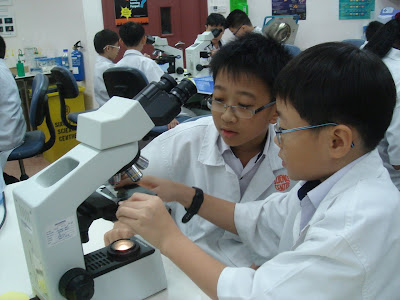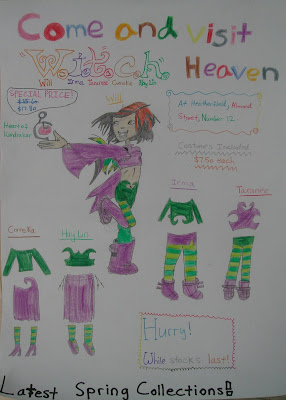Yuan Kai...
We went to the Science Centre on Wednesday. The purpose is to help us have a better understanding of the topic on cells. I learnt about the nucleus, cell wall, cell membrane, cytoplasm and chloroplast. I am going to find out what their functions are. I have learnt many things on this trip.
Phu Eindra Ko...
On 23 March, we went on a learning journey to the science centre. We were going there to cover the topic on cells. The instructor's name was Ms Claire. She taught us how to classify cells. She also let us do a lot of fun hands-on experiments. In one of them, we used a toothpick to collect some cells from the inside of our cheek. Then we put blue dye on them so that we can see them better under the microscope. I learnt that human and animal cells do not have a cell wall while the plant cell has a cell wall. I also learnt that the humans have many cells but bacteria and yeast have only one cell. It was really fun. I hope the school will organise more trips to the Science Centre.
Leona...
The instructor, Ms Claire, taught us the five main groups of the unit of life. They are animal, plant, fungi, bacteria and protist. Then we compared the difference between a plant cell and an animal cell. My partner, Vanessa, and I learnt how to operate a microscope. We took a leaf from the hydrilla plant and placed it on a glass slide. We covered the specimen with a thin glass piece to protect it. Then we placed it under the microscope and observed its shape. We also prepared other specimens for observation, such as the cheek cell and fungi cell (yeast). These two are transparent, so we had to dye them. I freaked out when I saw a long cheek cell of mine, but the instructor told us that the reaction of the dye caused it to look like that. It was fun and interesting. I look forward to our next excursion.
Kelly...
It was my first time using a microscope. I learnt about different types of cells like diatoms, amoeba, eugiena, volvox, rotifer, yeast, bacillus and coccus. I learnt that different cells have different shapes, like a string of circles, or it could be needle-shaped. It was a memorable trip.

Looking smart in our lab coats

Plucking a leaf from the hydrilla plant

Placing the leaf on the glass slide

Here's the specimen

Learning to use the microscope

Desmond writing down his observations
 Turn the nose piece to change the objective lens
Turn the nose piece to change the objective lens

Everyone knows what to do

Placing the specimen under the lens

Examining the specimen
 Taking turns to use the microscope
Taking turns to use the microscope

Timothy checking out the plant cell

Shawn and Desmond are ready with their specimen too
 Working together
Working together

Khee Han helps Han Chu to adjust the objective lens

Zhi Yi turning the focus knob to get a better focus of the specimen

Weng Leng gets a good look at the plant cells

Nerin using a toothpick to scrape the inside of the cheek to get some cheek cells
 Scrape the cheek cells onto the glass slide
Scrape the cheek cells onto the glass slide

Brian adding blue dye to his cheek cells

Place the glass piece over carefully, slanting it to prevent air bubbles from being trapped

Dab around the edges to dry the specimen

Thu Ta carefully drying the glass slide

Hey presto! The cheek cell specimen is ready.

Look how professionally Qun Mei places the specimen on the stage

A close-up picture to see how it's done

It's Mavis' turn now while Qun Mei looks on
 Practice makes perfect
Practice makes perfect
 Wilbert and Timothy examining the cheek cells
Wilbert and Timothy examining the cheek cells
 Leona claimed that she almost "freaked out" when she saw her strange-looking cheek cells
Leona claimed that she almost "freaked out" when she saw her strange-looking cheek cells









 Looking smart in our lab coats
Looking smart in our lab coats




 Turn the nose piece to change the objective lens
Turn the nose piece to change the objective lens


 Taking turns to use the microscope
Taking turns to use the microscope

 Working together
Working together 

 Weng Leng gets a good look at the plant cells
Weng Leng gets a good look at the plant cells
 Scrape the cheek cells onto the glass slide
Scrape the cheek cells onto the glass slide







 Practice makes perfect
Practice makes perfect Wilbert and Timothy examining the cheek cells
Wilbert and Timothy examining the cheek cells Leona claimed that she almost "freaked out" when she saw her strange-looking cheek cells
Leona claimed that she almost "freaked out" when she saw her strange-looking cheek cells






















 Done by: Thu Ta Aung
Done by: Thu Ta Aung